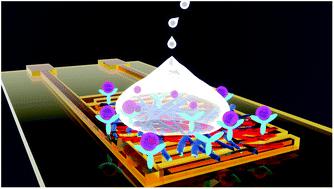Our official English website, www.x-mol.net, welcomes your
feedback! (Note: you will need to create a separate account there.)
Controlled molecular architectures in microfluidic immunosensors for detecting Staphylococcus aureus.
Analyst ( IF 3.6 ) Pub Date : 2020-08-06 , DOI: 10.1039/d0an00714e Andrey Coatrini Soares 1 , Juliana Coatrini Soares , Valquiria Cruz Rodrigues , Osvaldo N Oliveira , Luiz Henrique Capparelli Mattoso
Analyst ( IF 3.6 ) Pub Date : 2020-08-06 , DOI: 10.1039/d0an00714e Andrey Coatrini Soares 1 , Juliana Coatrini Soares , Valquiria Cruz Rodrigues , Osvaldo N Oliveira , Luiz Henrique Capparelli Mattoso
Affiliation

|
Detection of pathogenic microorganisms is essential for food quality control and diagnosis of various diseases, which is currently performed with high-cost, sophisticated methods. In this paper, we report on a low-cost detection method based on impedance spectroscopy to detect Staphylococcus aureus (S. aureus). The immunosensors were made with microfluidic devices made of interdigitated electrodes coated with layer-by-layer (LbL) films of chitosan and chondroitin sulfate, on which a layer of anti-S. aureus antibodies was adsorbed. The limit of detection was 2.83 CFU mL−1 with a limit of quantification of 9.42 CFU mL−1 for immunosensors with 10-bilayer LbL films. This level of sensitivity is sufficient to detect traces of bacteria that cause mastitis in milk, which we have confirmed by distinguishing milk samples containing various concentrations of S. aureus from pure milk and milk contaminated with Escherichia coli (E. coli) and Salmonella. Distinction of these samples was made possible by projecting the electrical impedance data with the interactive document mapping (IDMAP) technique. The high sensitivity and selectivity are attributed to the highly specific interaction with anti-S. aureus antibodies captured with polarization-modulated reflection absorption spectroscopy (PM-IRRAS), with adsorption on the antibodies explained with the Langmuir–Freundlich model. Since these immunosensors are stable for up to 25 days and detection measurements can be made within minutes, the methodology proposed is promising for monitoring S. aureus contamination in the food industry and hospitals, and in detecting bovine mastitis.
中文翻译:

用于检测金黄色葡萄球菌的微流免疫传感器中的受控分子结构。
病原微生物的检测对于食品质量控制和各种疾病的诊断是必不可少的,目前,这是通过高成本,复杂的方法进行的。在本文中,我们报告了一种基于阻抗谱的低成本检测方法来检测金黄色葡萄球菌(S. aureus)。免疫传感器由微流体装置制成,该装置由指状电极制成,电极上涂有壳聚糖和硫酸软骨素的逐层(LbL)膜,上面吸附了一层抗金黄色葡萄球菌抗体。检测极限为2.83 CFU mL -1,定量极限为9.42 CFU mL -1用于带有10双层LbL膜的免疫传感器。这种敏感性水平足以检测出导致牛奶中乳腺炎的细菌的痕迹,我们已经通过将纯牛奶和被大肠杆菌(E. coli)和沙门氏菌污染的牛奶中含有不同浓度金黄色葡萄球菌的牛奶样品区分开来进行确认。通过使用交互式文档映射(IDMAP)技术投影电阻抗数据,可以区分这些样品。高灵敏度和选择性归因于与抗金黄色葡萄球菌的高度特异性相互作用用偏振调制反射吸收光谱(PM-IRRAS)捕获的抗体,并用Langmuir-Freundlich模型解释了对抗体的吸附。由于这些免疫传感器在长达25天的时间内都可以保持稳定,并且可以在数分钟内完成检测测量,因此所提出的方法有望在食品工业和医院中监测金黄色葡萄球菌的污染,并检测牛乳腺炎。
更新日期:2020-09-14
中文翻译:

用于检测金黄色葡萄球菌的微流免疫传感器中的受控分子结构。
病原微生物的检测对于食品质量控制和各种疾病的诊断是必不可少的,目前,这是通过高成本,复杂的方法进行的。在本文中,我们报告了一种基于阻抗谱的低成本检测方法来检测金黄色葡萄球菌(S. aureus)。免疫传感器由微流体装置制成,该装置由指状电极制成,电极上涂有壳聚糖和硫酸软骨素的逐层(LbL)膜,上面吸附了一层抗金黄色葡萄球菌抗体。检测极限为2.83 CFU mL -1,定量极限为9.42 CFU mL -1用于带有10双层LbL膜的免疫传感器。这种敏感性水平足以检测出导致牛奶中乳腺炎的细菌的痕迹,我们已经通过将纯牛奶和被大肠杆菌(E. coli)和沙门氏菌污染的牛奶中含有不同浓度金黄色葡萄球菌的牛奶样品区分开来进行确认。通过使用交互式文档映射(IDMAP)技术投影电阻抗数据,可以区分这些样品。高灵敏度和选择性归因于与抗金黄色葡萄球菌的高度特异性相互作用用偏振调制反射吸收光谱(PM-IRRAS)捕获的抗体,并用Langmuir-Freundlich模型解释了对抗体的吸附。由于这些免疫传感器在长达25天的时间内都可以保持稳定,并且可以在数分钟内完成检测测量,因此所提出的方法有望在食品工业和医院中监测金黄色葡萄球菌的污染,并检测牛乳腺炎。









































 京公网安备 11010802027423号
京公网安备 11010802027423号